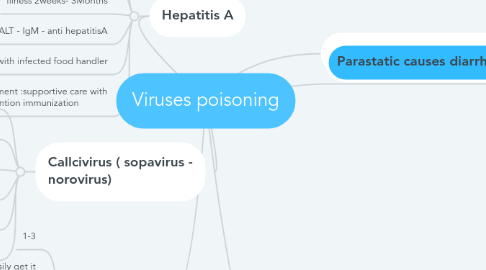
1. Rotavirus
1.1. 1-3
1.2. Vomiting - watery diarrhea - fever- temporary lactose intolerance can occur- infants and children elderly and immunodeficiency can easily get it
1.3. 4-8 days illness
1.4. Contaminated food ready to eat touched by infected food worker( salads and fruits)
1.5. Lab identification of virus in stool by immunoassay
1.6. Treatment supportive care severe diarrhea require fluid and electrolyte replacement
2. Callcivirus ( sopavirus - norovirus)
2.1. 12-24 incubation period
2.2. Nausea- vomiting- abdominal cramping-diarrhea- fever- myalgia-headache diarrhea in adult- vomiting in children - prolonged a symptomatic excretion possible
2.3. Illness 12-16 hours
2.4. Shellfish- contaminated food( food ready to eat) that infected by the workers : sandwiches- ice - salads-cookies-fruit
2.5. Lab: routine RT-PCR and EM on stool sample clinical diagnosis negative bacterial culture - negative WBCs in stool
2.6. Treatment: supportive such as rehydration good hygiene
3. Hepatitis A
3.1. 28 days
3.2. Diarrhea - dark urine - Jaundice - fluelike symptoms-
3.3. Illness 2weeks- 3Months
3.4. Lab increase ALT - IgM - anti hepatitisA
3.5. Raw produces- shellfish-contaminated water-uncooked food- and cooked food that are not reheated after contact with infected food handler
3.6. Treatment :supportive care with prevention immunization
4. Difference between bacteria and viruses poisoning
4.1. Bacteria
4.1.1. Cause gastroenteritis in age 2-4 years old
4.1.2. Could be there blood in feces
4.1.3. Leukocyte in feces
4.2. Viruses
4.2.1. Cause gastroenteritis in age less than 2 years old
4.2.2. No blood in feces
4.2.3. Do not multiply in food just in living host
4.2.4. Transfers from food to other
4.2.5. Hazardous food not needed for virus survive
5. Characteristics of the viruses
5.1. Few causes diseases
5.2. Food borne virus are relatively stable and acid resistant outside host cells
6. Parastatic causes diarrhea
6.1. Cryptosporidium parvum
6.1.1. Found in : contaminated water containing cysts from infected cattle (resist chlorination) -A self limiting diarrhoeal illness (N/V) in children or more severe in AIDS patients
6.2. Entamoeba histolytica
6.2.1. Found in: food contaminated with cysts -Amoebic dysentry: Severe bloody diarrhea____}ulceration of the colon, peritonitis, hepatitis.
6.3. Giardia lamblia
6.3.1. Found in : ingestion of cysts in contaminated food or water (resists chlorination)____}develop into trophozoites in duodenum - Symptoms: cramping, pain, flatulence, diarrhoea, N/V, flatulence (NO fever and fecal leukocytes)
6.4. Diagnosing Cause of Diarrhea
6.4.1. • Food • Detailed history of food eaten 3 days prior to onset of symptoms
6.4.2. History • Travel to endemic areas of world • Recreational activities • Exposure to ill patients
